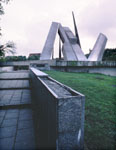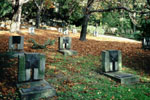1999 Photographs from Poznan | Panoramic Photograph | Poland Site Index | Home
Initially, I thought I set aside too much time for Poznan. I had quickly seen the center of the city yesterday afternoon and early this morning. It was now time to travel a bit farther afield and away from the commercial heart of Poznan. My walk took me east to an island situated in the middle of the Warta River. The buildings and the small churches on the island and the opposite bank are some of the earliest Gothic structures and settlements of region.


Reaching the cathedral on Ostrów
Island, I was amazed by the quality of the stone patterning at
the exterior forecourt of the building. The scale, color and
texture of the stones made the design highly appealing. The bricks
of the church also form a unique pattern.  Some
bricks are glazed, others are matted and no two are exactly alike
since each was produced by hand. The cathedral's overall form
is a monolith composed of many small parts. Design embellishments
occur mainly at the entrance where a pattern of glazed and matte
surfaced bricks surrounds the entrance doors. The churches on
the opposite bank of the Warta are much smaller in scale but
no less interesting. The church of St John of Jerusalem (Kosciól
Sw Jana Jeromzolimskiego) was constructed in the 12th century
with various additions creating the present-day asymetrical side
aisle building.
Some
bricks are glazed, others are matted and no two are exactly alike
since each was produced by hand. The cathedral's overall form
is a monolith composed of many small parts. Design embellishments
occur mainly at the entrance where a pattern of glazed and matte
surfaced bricks surrounds the entrance doors. The churches on
the opposite bank of the Warta are much smaller in scale but
no less interesting. The church of St John of Jerusalem (Kosciól
Sw Jana Jeromzolimskiego) was constructed in the 12th century
with various additions creating the present-day asymetrical side
aisle building.
 Crossing
back over the river, I decided to go north towards some of the
city's less known sites. It was well worth the walk. Situated
at the top of a hill on an unassuming site is a memorial to the
Poznan Army, commemorating the force which held the Nazis at
bay for over 2 weeks. Angular polished steel spikes rise up from
the ground against an overshadowing and more powerful group of
black granite obelisks. On first site, the composition looks
like chaos. Below this collision is a horizontal concrete roof
plane with an opening to the sky allowing light to fall on a
central marker. The rear wall of the structure contains the names
of the many other cities which were besieged during World War
II.
Crossing
back over the river, I decided to go north towards some of the
city's less known sites. It was well worth the walk. Situated
at the top of a hill on an unassuming site is a memorial to the
Poznan Army, commemorating the force which held the Nazis at
bay for over 2 weeks. Angular polished steel spikes rise up from
the ground against an overshadowing and more powerful group of
black granite obelisks. On first site, the composition looks
like chaos. Below this collision is a horizontal concrete roof
plane with an opening to the sky allowing light to fall on a
central marker. The rear wall of the structure contains the names
of the many other cities which were besieged during World War
II.
The memorial is impressive in it's design by directly conveying the intended meaning: the efforts of the shining silver swords against an overpowering evil. The use of materials and forms is both heavy and light at once. It is a simple concept and it is executed very well. The design is obviously intended for large gatherings since its open design could easily accommodate overflow crowds. Weather protection for dignitaries and honorees is provided by the horizontal canopy.
 Walking
around the memorial, I thought of Poland's recent past and how
heavily it must weigh on the present. Having your country overrun
can not be so easy to forget. Should such events be remembered
or eventually forgotten? Examining the memorial's construction
shows that it has not been fully tended. Granite coping and cladding
stones along the rear walkway are either damaged or missing.
Salt staining can be seen on the concrete wall of city names,
evidence of a weatherproofing failure. Even concrete can not
stand forever if it is left totally unattended. How well will
Poland care for its more recent memories?
Walking
around the memorial, I thought of Poland's recent past and how
heavily it must weigh on the present. Having your country overrun
can not be so easy to forget. Should such events be remembered
or eventually forgotten? Examining the memorial's construction
shows that it has not been fully tended. Granite coping and cladding
stones along the rear walkway are either damaged or missing.
Salt staining can be seen on the concrete wall of city names,
evidence of a weatherproofing failure. Even concrete can not
stand forever if it is left totally unattended. How well will
Poland care for its more recent memories?

 Walking farther past the memorial
leads to one of Poznan's largest city parks, the Citadel. The
entrance is marked by a grand staircase leading to a large rough
stone obelisk. On the slopes to either side of the staircase
are the grave sites of Russian, British, American and Polish
soldiers and prisoners killed during the first and second World
Wars. Again, the cemetery is a vivid reminder of Poland's resent
past even though most of the graves belong to outsiders. The
layout of each section of the cemetery varies greatly. Russian
graves are marked by low dark stone markers with a single red
star. The markers are dispersed among the trees in a relatively
informal manner. Each headstone has a portion of its base removed
from contact with the ground. The day I saw it, the stones appeared
to hover above a bed of fallen leaves. The English graves are
more formally planned and the whiteness of the stones gives a
distinct separation from the natural surroundings. Headstones
are grouped singly or in pairs. A few groupings of three markers
can also be found. What is the significance of these numbers?
I do not know.
Walking farther past the memorial
leads to one of Poznan's largest city parks, the Citadel. The
entrance is marked by a grand staircase leading to a large rough
stone obelisk. On the slopes to either side of the staircase
are the grave sites of Russian, British, American and Polish
soldiers and prisoners killed during the first and second World
Wars. Again, the cemetery is a vivid reminder of Poland's resent
past even though most of the graves belong to outsiders. The
layout of each section of the cemetery varies greatly. Russian
graves are marked by low dark stone markers with a single red
star. The markers are dispersed among the trees in a relatively
informal manner. Each headstone has a portion of its base removed
from contact with the ground. The day I saw it, the stones appeared
to hover above a bed of fallen leaves. The English graves are
more formally planned and the whiteness of the stones gives a
distinct separation from the natural surroundings. Headstones
are grouped singly or in pairs. A few groupings of three markers
can also be found. What is the significance of these numbers?
I do not know.
Moving uphill from the English
graves is a large rectangular box clad in white stone, resting
at the top of an informal staircase. The box has large bronze
letters, "1939-1956" This box is a Russian memorial
but the path and stairs leading towards it is lined with English
graves. This is no ordinary stair, either. The treads are slightly
long and risers are very short, requiring a slow and deliberate
step to navigate. It is not possible to run past the graves and
approach the main box quickly. The process of moving is slow
and requires full attention. It makes you think about what is
happening.
